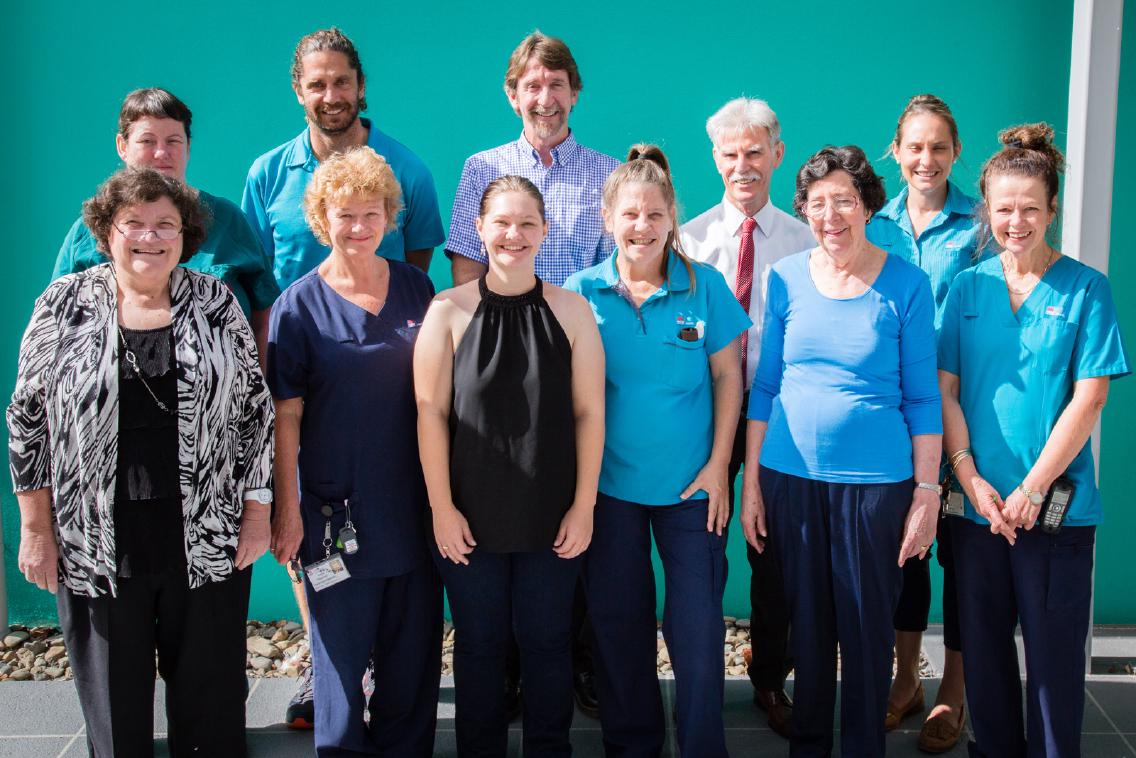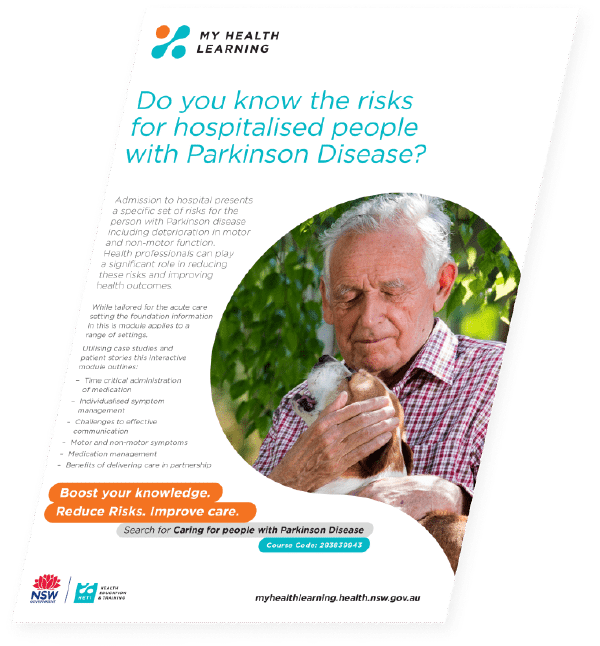Consumer Experience
Michael Ortiz has Parkinson’s Disease . Like many with this disease, he’s been hospitalised on many occasions for conditions other than Parkinson’s Disease. On too many of those occasions, according to Michael, the medication levodopa , vital to help him with his Parkinson’s symptoms wasn’t administered on time and his stay in hospital and levels of comfort were impacted.
As a trained pharmacist Michael was keen to improve outcomes for himself and others. He reached out to the CEC’s Medication Safety team. He also sought out the best clinical practice in caring for patients with Parkinson’s Disease.
Michael Ortiz
Michael Ortiz recalls his steps towards the issue of a Safety Notice for Parkinson’s medications.
After my third lot of surgery I was in a rehab hospital and I was receiving treatment and I was really disappointed with the way I was treated in terms of the medication and how I was allowed to self medicate and the fact that my medication was very rarely on time in the hospital so therefore I decided I would do something about it. What I did next I basically talked to some of my colleagues – one of my team members was working in the state department of health and I approached her about where could I take the issue about medication administration in the hospital and she directed me to the CEC. So I contacted the CEC and made an arrangement to meet with the pharmacists that work for the CEC in relation to the use of Levodopa in hospitals. Two lovely young female pharmacists who had obviously been there a while – very competent very aware of what was going on, they were able to point me to a safety alert from 2003 which was quite old. We talked about what we could do about it. The CEC then consulted more widely – I know they spoke to Parkinson’s NSW, they spoke with some of the practitioners like the people at Coffs Harbour. One the Parkinson’s nurses up there is doing a wonderful job, so they consulted widely and they came up with a revised advice.
The Clinical Team
The clinician doing a wonderful job according to Michael Ortiz, is Vince Carroll, Parkinson’s Clinical Nurse Consultant at Coffs Harbour Hospital, Mid North Coast Local Health District. Vince Carroll and two other clinicians Jess Andrews, a pharmacist and Kirsten Deutschmann, an occupational therapist, led a multidisciplinary team in an award-winning clinical practice improvement project to improve safety in this vulnerable patient group addressing medication management.

Coffs Harbour Hospital Parkinson’s Disease project. Left to right Back row: Dr Cathy Constantine, Emergency Department Staff Specialist; Joe Bryant, Physiotherapist; Vince Carroll, Parkinson’s Clinical Nurse Consultant team leader; Dr Iain Bruce, Visiting Medical Officer; Brodie Bannister, Dietician. Front Row: Alice Baker, Consumer; Angie Fitzgerald, Clinical Nurse Specialist, Aged Service Emergency Team; Jess Andrews, Pharmacist in Medical Ward (team leader); Marion Schausberger, Speech Pathologist; Jane Gow, Consumer, Coffs Harbour Parkinson’s Support group coordinator; Kay Maunsell, Emergency Department Pharmacist.
In their project, conducted at Coffs Harbour Hospital, the team found in patients with Parkinson’s Disease who were admitted to hospital each year only 44 per cent were receiving medications on time. Delaying medications for greater than 15 minutes can worsen tremors, rigidity, confusion, agitation, and anxiety. The Coffs Harbour team's interventions focused on bridging departmental and professional barriers with exact medication routines, identifying and avoiding certain medications harmful to patients with Parkinson's Disease and identifying alternatives for when a person cannot take medication orally. Results showed improvements in patients having medications on time, a reduction in average length of hospital stay for Parkinson's Disease as a secondary diagnosis, from 9 to 6.2 days, more rapid access to correct medications, improved teamwork and consumer satisfaction. In addition to the contribution of the project to the CEC’s safety notice, it also was influential in development of the Parkinson’s education module on My Health Learning and has been foundational to a research collaboration between Parkinson’s NSW, the Mid North Coast Local Health District and Charles Sturt University on the benefits of a Parkinson’s specialist nurse.
Results showed a reduction in average length of hospital stay for Parkinson's Disease as a secondary diagnosis, from 9 to 6.2 days.

Vince Carroll, Parkinson’s Clinical Nurse Consultant team leader
Having the safety notice updated in one page, you know you can really just highlight the importance of Parkinson’s medications are just as crucial as insulin and that’s how it should be treated and a Safety Notice carries a lot of weight you know because it comes out from the Clinical Excellence Commission
The project that I was leading at Coffs Harbour was really the catalyst for all this because the length of stay had dropped from 9 days to 6 days with this project and everyone was going wow this is amazing, the chief executive said this is amazing what you guys are doing because we are shaving 3 days off the hospital stay. All this momentum was rolled into research, Charles Sturt came on board, Parkinson’s NSW funded the Charles Sturt research and we had a partnership with the Health District but one of the catalysts is that we needed to update that safety notice so that’s where Michael Ortiz came in, Michael and I got to meet cause through this web of improvement, Michael was driving change himself and I was driving change at the hospital with the team, Parkinson’s NSW were driving change and supporting the funding of Charles Sturt, so we all seemed to have got together in a really good partnership. Michael joined in with the team at CEC, I asked the CEC if the movement disorder chapter of the Australian Neuro nurses could also be represented so David Tsui is the Chair of that group and David and I have worked closely together David came on board as well so that Safety Notice was endorsed by that group as well which gave it a lot of weight and it was also endorsed by Parkinson’s NSW as the peak body so that was just the safety notice that we had so we were just so happy and stoked that that Safety Notice got over the line and got published in 2020 which we were very happy about, the job wasn’t finished there We wanted to have the HETI Program as part of this project at Coffs Hospital, I put a submission forward to HETI through the Health service and then they took it on board and that also came out in 2020. The safety notice, though having the safety notice updated in one page, you know you can really just highlight the importance of Parkinson’s medications are just as crucial as insulin and that’s how it should be treated and a Safety Notice carries a lot of weight you know because it comes out from the Clinical Excellence Commission, so a very peak body is saying this is what we all should be doing together to make a person with Parkinson’s stay in hospital less troublesome.
Changes to clinical practice made by the team included simply moving medications to make them easier to access.
The very simple thing was the ED staff said well let’s put the first line medications in the Emergency Department and lets trial that and see how it works so that was just a simple fix but that took cultural change to make it happen.
Well that came through the multidisciplinary team so we had medical staff, we had two doctors on that team a visiting medical officer and an ED doctor and we had pharmacists, we had OTs and physios and nurses we had great representation, we had probably had 18-24 people who would come to a monthly meeting that went on for a couple of years and they became the clinical champions to help drive that change so for example in the Emergency Department, one of the biggest issues people would come in after hours a lot of the time and you just couldn’t access the medication because they’re in the main pharmacy to get to the main pharmacy you had to get the after hours nurse manager who was covering a very busy hospital to go to the after hours cupboard and find the medications and that could take hours and we know that 15 minutes can make a difference, so if a person doesn’t have their medications for hours so we know there’s going to be some kind of impact or adverse effect that’s going to happen to those people with Parkinsons and ultimately extend their stay and affect their swallowing affect their mobility affect their level of anxiety and it becomes complicated and people can fall over and people stay longer in hospital and some people can die so the very simple thing was the ED staff said well lets put the first line medications in the Emergency Department and lets trial that and see how it works so that was just a simple fix but that took cultural change to make it happen, so the ED pharmacist was part of our team and they made that change happen in Emergency Departments and those changes are still in there today, I can go into there today and into the cupboard and get easy access to the medication, on the wards because we didn’t have the electronic medical record medication component back then when we were still using hard copy medication charts, we were using stickers – we put time critical stickers on their adverse events contraindication medication stickers, so not to use anti psychotics like halaperodol, stickers went on the medication charts so that was done by pharmacists working the wards. and then we had clocks that would go near the patient’s bed so the staff would write on the clock, medication is due at 6, 11 and 4 in the afternoon so there was a visual cue for people to see when the medications were due. So we did all these changes and then we measured the changes, we did education programs and we measured the level of knowledge before and after, and all the changes we did actually became normal practice which was amazing because we made such an impact, everything just seemed to work cause we followed the quality improvement process and all the tools that you use to show that we made a difference and all these things just happened to work which we knew, we knew they were going to work.
Michael Ortiz and Vince Carroll have published articles on improvements to Parkinson's medication management in hospitals. Michael’s paper is ‘On time – every time’ and Vince Carroll has documented results of the project in Coffs Harbour in ‘Purposeful collaboration: Enriching lives for people with Parkinson’s disease’ .
The CEC Medication Safety Team
The CEC’s Medication Safety team supports the safe and quality use of medicines by identifying and addressing emerging medication safety risks. Use of medicines is one of the most common therapeutic interventions in Australian hospitals. It is also one of the most complex, with delivery of each dose of medicine involving as many as 30 steps and almost as many people. Because they are so commonly used, medicines are associated with a higher incidence of errors and adverse events than other healthcare interventions. In NSW, medication and intravenous fluid related incidents are the second most frequently reported incident type, with a significant number of these incidents resulting in patient harm.
Because they are so commonly used, medicines are associated with a higher incidence of errors and adverse events than other healthcare interventions.
The Medication safety team also contributed to development of a new online course for clinicians released in March 2020, Caring for people with Parkinson’s Disease.

Poster targeting clinicians from the Health, Education and Training Institute promoting an online course: Caring for people with Parkinson’s Disease.
In 2019-20 the CEC distributed 12 medication safety communications and 13 medication safety updates as part of the CEC’s primary function to minimise potential harm.
In addition to the issue of medication safety alerts and updates, in 2019-20 the CEC Medication Safety team:
- created medication-related resources specific to COVID-19 for health professionals including guidance on safe handling of medicines for COVID-19 patients
- assisted development of an eLearning module on the Safe Use of Opioids released in October 2019 and
- translated key medication guidelines into community languages including the antibiotic, opioid and venous thrombo-embolism resources for patients, carers and families.
CEC Expertise
Nina Muscillo has held the role of Senior Manager Medication Safety in the Clinical Excellence Commission for almost 6 years. Nina started her career as a community pharmacist in Queensland and then moved into the area of medication safety within the public health system in 2004. Her role as Senior Manager at the CEC includes leading a team in a range of medication safety and quality improvement initiatives and coordinating responses across public NSW hospitals to severe medication incidents and medication shortages/recalls that impact patient safety. Nina also provides advice on medication safety issues at state and national levels.
Nina Muscillo, Senior Manager Medication Safety
Nina reflects on the importance of the partnership with consumers and the steps taken to release the Safety Notice on Parkinson’s Disease care.
Medications can be quite complex and patients will come in with a number of different medications so it’s not just the complexity of each single medication its to how they work together, there’s also so many steps in the medication management process, so there can be over 30 steps between the time the medicine comes from the pharmacy to the patient at their bedside and is administered. Consumers, carers are really important when we’re actually developing initiatives and also for evaluating the initiatives because they are the ones at the end of the day where we are actually wanting the change to occur for improvements in care and safe care to occur. Michael contacted us, through the generic inbox which is on our CEC website so he just provided just some comments regarding prescribing and administration of Parkinson’s Disease medicines to patients within hospital and how they weren’t timely enough and the impact this was having, could have, well did have on himself and other Parkinson’s Disease patients. So we responded to Michael and provided him with some information and directed him to our safety notice which we currently had on our Safety Alert broadcast system, the Safety Notice had been produced in 2011 but it had been reviewed and we knew the information was still relevant. He acknowledged that and he then was extremely disappointed that even though we had this information available it wasn’t actually being done in the hospital system and it wasn’t his experience and at that point our Director, Harvey, tried to ring Michael to have some further discussion to see how we could help. Michael also did a lot of research himself and had a lot of information and he was able to provide a lot of information on what he found was working well so we could incorporate those recommendations into our information. So we took it to our Med Safety Expert Advisory Committee and they agreed we should update our Safety Notice so we contacted Parkinson’s NSW who were the initiators of the initial notice to discuss with them updating the notice and we put that into place. During this time, we also received contact from HETI (Health Education and Training Institute) that they were thinking of doing a Parkinson’s Disease module to assist clinicians as well so this just happened to be perfect timing so we were able to partner with them, assist with that Parkinson’s module and release the Safety Notice at the same time, that way it was actually a multi-factual approach so, providing some guidance and policy or recommendations at the state level then bring in the HETI module to support the training for staff as well.
Consumers, carers are really important when we’re developing initiatives and also for evaluating the initiatives because they are the ones at the end of the day where we are wanting the change to occur for improvements in care.

